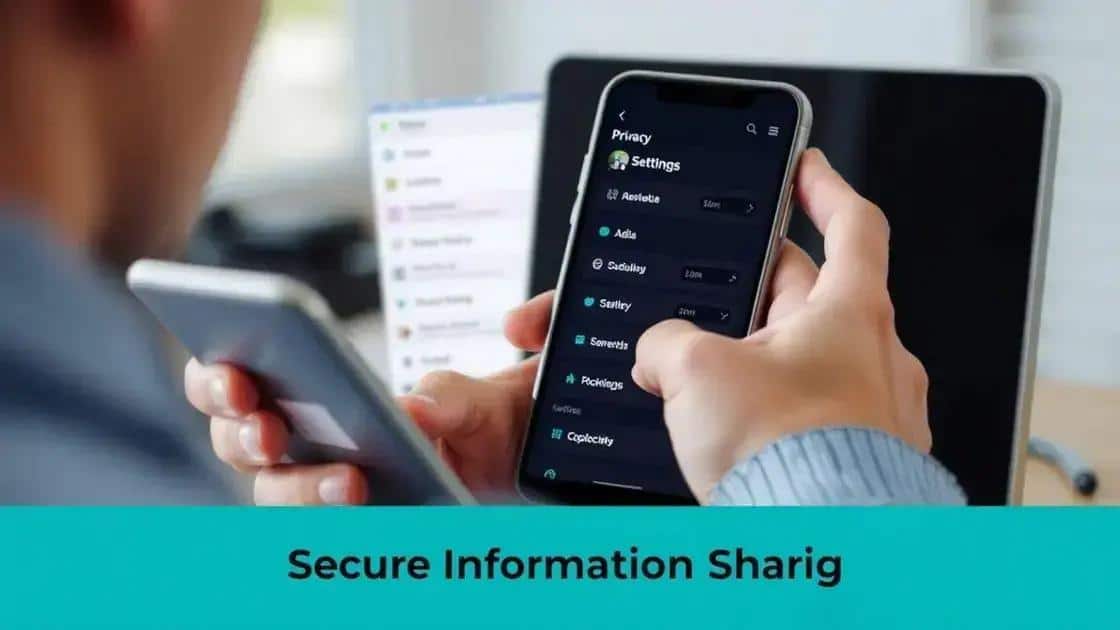Phone social security tips you need to know now

To protect your identity online and recognize scams, use strong passwords, enable two-factor authentication, and be cautious when sharing personal information.
Phone social security tips are vital in today’s digital age. Have you ever wondered how fraudsters might exploit your personal information via your phone? Let’s discuss ways to protect yourself.
Recognizing social security scams
Recognizing social security scams is crucial for protecting your personal information. With the rise of phone scams, knowing what to look for can make a big difference. Scammers often impersonate legitimate entities to trick victims into revealing sensitive data.
Common signs of a social security scam include unsolicited calls, threats of arrest, or promises that seem too good to be true. If someone contacts you claiming to be from the Social Security Administration and demands immediate payment or personal information, it’s likely a scam.
Tips to Identify Scams
To avoid falling victim to these scams, here are some tips to help you recognize them:
- Legitimate agencies won’t ask for personal information over the phone.
- Be cautious of callers who create a sense of urgency.
- Verify the caller’s identity by calling back using official numbers.
It’s also important to keep your guard up when receiving unexpected messages. Scammers use various tactics, like spoofing legitimate phone numbers, to deceive individuals. Always double-check the source before taking action. If in doubt, hang up and reach out directly to the institution in question.
Reporting Suspicious Calls
If you encounter a suspected social security scam, report it immediately. You can report such calls to the Federal Trade Commission (FTC) or your local consumer protection agency. This helps authorities track down scammers and can prevent others from falling victim as well.
Staying informed and aware is your best defense against social security scams. Equip yourself with knowledge, and you’ll be better prepared to navigate these tricky situations. By understanding the common tactics used by scammers, you safeguard yourself against potential fraud.
Secure your phone against threats
To secure your phone against threats, it’s essential to take proactive steps. With smartphones being a major part of our lives, they can also attract unwanted attention from hackers and scammers.
First, always keep your phone’s software updated. Updates often include security patches that protect against new vulnerabilities. By not updating, you leave your device exposed to potential threats.
Essential Security Practices
There are several practices to follow for enhancing your device’s security:
- Use a strong password or biometric authentication.
- Enable two-factor authentication whenever possible.
- Be cautious when downloading apps; install only from trusted sources.
- Regularly review app permissions and delete unnecessary apps.
Another effective way to secure your phone is to install a reputable security application. This software can help detect malware and alert you about suspicious activities. Additionally, consider using a VPN to protect your internet connection, especially on public Wi-Fi networks.
Safe Browsing Habits
Practicing safe browsing habits is equally important. Avoid clicking on unknown links or attachments in emails and texts. Scammers often use these methods to compromise devices. Also, educate yourself about phishing scams. Knowing how to recognize these can significantly reduce the risk of being tricked.
Remember that maintaining security is an ongoing process. Regularly check for updates and engage with the latest security practices. The more informed and cautious you are, the better you can protect your personal information from threats.
Best practices for sharing personal info

When it comes to sharing personal information, following best practices is essential for keeping your data safe. In our digital age, protecting your privacy should be a top priority.
Before sharing any sensitive information, always ask yourself why it is needed and how it will be used. This simple question can help you think critically about whether to share your data.
Key Best Practices
Here are some key best practices for sharing personal info:
- Limit information to what is necessary.
- Check the credibility of the person or organization asking for information.
- Use secure methods to transmit sensitive data, like encrypted emails or secure websites.
In addition to these practices, be aware of your surroundings when sharing personal information in public. Avoid discussing sensitive details in crowded places or using public Wi-Fi without protection. Cybercriminals often exploit unsecured networks to intercept data.
Understanding Privacy Settings
Another crucial element to consider is understanding the privacy settings on your devices and social media accounts. Review and adjust these settings regularly to control who can see your information. Make sure that you are aware of what you are sharing and with whom.
Personal information includes things like your full name, address, phone number, and financial details. Always think twice before sharing these details online, especially on social media platforms where visibility is high.
By being informed and cautious, you can effectively protect your personal information and minimize the risk of identity theft or fraud.
How to report a scam or fraud
Knowing how to report a scam or fraud is vital for protecting yourself and others. If you encounter a scam, taking swift action can help minimize harm.
Start by collecting all relevant information about the scam. Keep records of emails, messages, and any details about the scammer. This information helps authorities investigate more effectively.
Steps to Report a Scam
Here are the steps you should follow to report a scam:
- Identify the type of scam you experienced or witnessed.
- Visit the official website of your local consumer protection agency or the Federal Trade Commission (FTC).
- Fill out an online complaint form or call the appropriate hotline.
In addition to reporting to local authorities, you should also inform your bank or credit card company if financial information was compromised. They can help secure your accounts and prevent further losses. If you shared sensitive data with someone you now suspect is a scammer, consider placing a fraud alert on your credit reports.
Informing Others
Spreading the word can also be helpful. Share details of the scam with friends and family to prevent them from falling victim. Social media can be an excellent platform for raising awareness about the scam you encountered.
It’s important to remember that victims of scams should not feel ashamed. Scammers are skilled at manipulation, making it easy for anyone to fall into their traps. Reporting scams not only helps protect yourself but also assists in protecting your community.
Keeping your identity safe while online
Keeping your identity safe while online is increasingly important in today’s digital world. With more personal information being shared over the internet, knowing how to protect yourself is vital.
Start by using strong and unique passwords for each of your accounts. A password manager can help you generate and store these passwords securely. Be sure also to enable two-factor authentication wherever possible. This adds an extra layer of security.
Be Cautious with Personal Information
When sharing personal information, be selective and cautious. Here are some tips to consider:
- Avoid oversharing on social media.
- Check privacy settings on all accounts to ensure they are set to your preference.
- Don’t share sensitive information through unsecured channels, like email or text messages.
Furthermore, be aware of phishing scams. These scams can appear as legitimate communications from trusted sources, but they often aim to steal your personal information. Always verify the sender before clicking links or downloading attachments.
Use Secure Connections
Using secure connections is another key aspect of maintaining your safety. Always look for “HTTPS” in your browser’s address bar when entering sensitive information on websites. This indicates that the site is using encryption to protect your data.
Regularly monitor your financial accounts and personal information for any signs of suspicious activity. By being proactive and vigilant, you can help ensure that your identity remains safe while navigating the online world.
FAQ – Frequently Asked Questions About Online Security and Scams
What should I do if I receive a suspicious email asking for personal information?
Do not click any links or download attachments. Verify the sender’s identity and report the email to your email provider.
How can I create strong passwords for my accounts?
Use a mix of letters, numbers, and symbols. Avoid common words or phrases, and consider using a password manager to help generate and store them.
What are the signs of a phishing scam?
Look for urgent language, misspellings, and requests for sensitive information. Always verify links by hovering over them before clicking.
Why is it important to use two-factor authentication?
Two-factor authentication adds an extra layer of security, making it harder for unauthorized users to access your accounts, even if they have your password.





